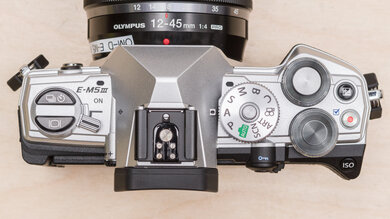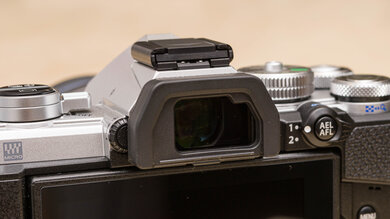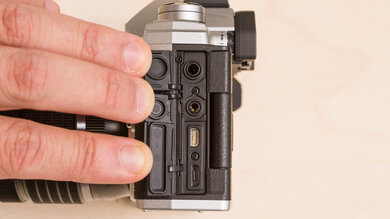The Olympus OM-D E-M5 Mark III is a Micro Four Thirds mirrorless camera with retro styling that calls to mind Olympus's classic line of 'OM' SLR cameras. It's a small, lightweight interchangeable lens camera that delivers excellent image quality, rivaling cameras with larger sensors. It's a great option for vlogging thanks to its good video quality, low light capability, and excellent in-body image stabilization. It also has a fully articulated screen to monitor yourself as you record or help you take photos from unconventional angles. Its autofocus system is excellent at tracking moving subjects when shooting video, but it's just okay for photography using its out-of-the-box settings. Unfortunately, its battery life is mediocre, though this can vary with real-world conditions, and you can't use it while it charges.
Our Verdict
The Olympus OM-D E-M5 Mark III is good for travel photography. It's small and lightweight, making it easy to take with you wherever you go. It also has great overall image quality for its class. Unfortunately, its battery life is mediocre, although this can vary depending on your usage habits and choice of settings. That said, it feels well-built, and the screen gets bright enough to overcome glare in sunny conditions.
-
Great overall image quality.
-
Well-built, portable design.
-
Bright, fully articulated screen.
-
Amazing in-body image stabilization.
-
Mediocre battery life.
-
May be too small for extra large hands to hold comfortably.
-
Photo autofocus is just okay.
The Olympus OM-D E-M5 Mark III is good for landscape photography. Its image quality is great overall, with good dynamic range to bring out a fair bit of detail in landscape shots. It also feels well-built with a fully articulated screen that gets bright enough to overcome glare from the sun, and it's weather-sealed. It's lightweight and portable, making it easy to take to remote shooting locations, but its small size can make it uncomfortable to hold for those with larger hands.
-
Great overall image quality.
-
Well-built, portable design.
-
Bright, fully articulated screen.
-
Good dynamic range.
-
Mediocre battery life.
-
May be too small for extra large hands to hold comfortably.
-
Photo autofocus is just okay.
The Olympus OM-D E-M5 Mark III is decent for sports and wildlife photography. Relatively speaking, its image quality is great. It also has a very quick shooting speed with a virtually instant buffer empty time, so you can capture fast action in quick bursts without slowing down. It has an amazing in-body image stabilization feature, which can help reduce camera shake when shooting at long focal lengths without a tripod. However, its autofocus system is just okay for photography, as it does a poor job of tracking moving faces.
-
Great overall image quality.
-
Quick shooting speed.
-
Amazing in-body image stabilization.
-
Mediocre battery life.
-
May be too small for extra large hands to hold comfortably.
-
Photo autofocus is just okay.
The Olympus OM-D E-M5 III has decent RAW image quality. It has a good amount of dynamic range, so it captures a fairly wide range of highlight and shadow detail. However, it only does a decent job of resolving fine detail, so you don't have as much leeway to crop in without losing visible sharpness. Its low-light noise handling is also only decent, though it performs on par with most other Micro Four Thirds sensors.
-
Good dynamic range.
-
Noise handling and resolution are just decent.
The Olympus OM-D E-M5 Mark III is amazing for vlogging. It's relatively compact and lightweight, making it easy to take on the go, and it has a fully articulated screen to help you monitor yourself while recording. Its five-axis in-body stabilization feature does an excellent job of smoothing out camera shake. The autofocus system also does a great job of tracking faces, ensuring you stay in focus while vlogging. It also delivers fantastic video quality when shooting in low light in either 4k or FHD, but it introduces more noise in brighter conditions, especially in FHD.
-
Well-built, portable design.
-
Bright, fully articulated screen.
-
Amazing in-body image stabilization.
-
Great autofocus performance for video.
-
Mediocre battery life.
-
May be too small for extra large hands to hold comfortably.
-
Video has a 2x crop.
The Olympus OM-D E-M5 Mark III is good for studio video. Its video quality is great overall, and it looks especially good in low light, with minimal noise and grain. The menu system is passable but can be somewhat hard to navigate. On the upside, it has a good array of inputs and outputs, including a microphone jack and a micro HDMI port that supports clean HDMI output, so you can connect an external recorder without any overlays. However, it doesn't have a headphone jack. For those who prefer to work with higher quality video files, it also supports All-I compression in FHD.
-
Great autofocus performance for video.
-
Supports clean HDMI output.
-
Impressive video quality in low light.
-
Supports All-I compression in FHD.
-
May be too small for extra large hands to hold comfortably.
-
No headphone jack.
-
Video has a 2x crop.
The Olympus OM-D E-M5 Mark III is okay for action video but isn't meant for this use. It's portable and lightweight but isn't designed to mount on a helmet or action camera rig. Also, while it's weather-sealed to protect it from some dust and rain, it's not fully waterproof. While it can't record at frame rates above 30 fps in 4k, it does have a slow-motion feature in FHD that can record at 120 fps for slow-motion playback.
-
Well-built, portable design.
-
Amazing in-body image stabilization.
-
Great autofocus performance for video.
-
Impressive video quality in low light.
-
Not designed for helmet rigs and action cam mounts.
-
Not waterproof.
-
Video has a 2x crop.
-
Frame rates are somewhat limited for action video.
- 7.6 Travel Photography
- 7.6 Landscape Photography
- 7.4 Sport & Wildlife Photography
- 7.3 Raw Photo Performance
- 8.7 Vlogging
- 7.9 Studio Video
- 5.9 Action Video
Changelog
- Updated Jan 29, 2024: Added text to the 'Raw Photo Performance' verdict box and updated existing verdict boxes for clarity and accuracy.
- Updated Jan 29, 2024: Converted to Test Bench 0.12.1.
- Updated Dec 20, 2023: Added a link to the OM SYSTEM OM-5 in the Sensor box.
- Updated Dec 13, 2023: Updated review to fix an error with the Photo RAW Noise graph and corrected the camera's low continuous shooting speed from 5 fps to 1 fps in the Photo Shooting Speed box to reflect the camera's minimum shooting speed.
- Updated Apr 24, 2023: Converted to Test Bench 0.12.
Check Price
Differences Between Sizes And Variants
The Olympus OM-D E-M5 Mark III comes in two color variants: 'Black' and 'Silver'. We tested the 'Silver' variant with an Olympus M.Zuiko Digital ED 12-45mm f/4.0 PRO lens, but we expect the 'Black' version to perform the same. You can also purchase this camera in either color without a lens.
If you come across another variant or your Olympus OM-D E-M5 doesn't correspond to our review, let us know in the discussions, and we'll update the review.
You can see our unit's label here.
Compared To Other Cameras
The OM SYSTEM OM-5 and the Olympus OM-D E-M5 Mark III are very similar cameras. The OM-5 features a newer processor, which gives it a few extra features over the E-M5 Mark III, including 'Starry Sky AF' and a digital 'Live ND' feature. That aside, however, it doesn't offer enough improvements to justify a higher price.
The Olympus OM-D E-M1 Mark III is more well-rounded than the Olympus OM-D E-M5 Mark III. It has a faster max continuous shooting speed, offers better battery life, and feels more comfortable to shoot with thanks to its larger handgrip and slightly larger EVF. It also has an extra SD card slot, a headphone jack, and records video at higher bit rates. On top of that, the E-M1 III has some extra features that the E-M5 III lacks, like a digital ND filter. That said, if portability is your priority for something like travel or vlogging, the E-M5 Mark III is more compact and offers roughly equivalent image quality, since both cameras use the same sensor with similar processors.
The OM SYSTEM OM-1 is a step up from the Olympus OM-D E-M5 Mark III, with a newer stacked sensor that gives it better overall image quality and low-light performance, along with significantly better video specs. It also has a higher-resolution EVF and feels better constructed. That said, the E-M5 Mark III is a much more portable camera and offers a lot of the same computational photography features, like a high-res composite photo mode.
Test Results
- Body is made of premium-feeling plastic
- Comes with an external flash that can be attached to the hot shoe and feels sturdy
- SD card and battery compartment are covered by locking hinged doors
- Inputs are covered by flimsy, loose-fitting rubber flaps
- Battery grip connection door is just an unconnected plastic cover that may be easily lost
- Buttons feel okay
- If you'd prefer a better-built camera with similar features, check out the OM SYSTEM OM-1
- Olympus OM-D E-M5 Mark III camera body
- Olympus M.Zuiko Digital ED 12-45mm f/4.0 PRO lens
- Microfiber sleeve
- Lens pouch
- Front and rear lens caps
- Sensor cap
- Lens hood
- Olympus FL-LM3 external flash
- Olympus BLS-50 battery
- Olympus BCS-5 battery charger
- AC adapter
- USB-A to micro-USB cable
- Shoulder strap
- Lens pamphlet
- User manual
- Suitable for most hand sizes and grips but may be too small for extra large hands
- Handgrip is shallow and not as grippy as some other cameras
- Thumb rest feels very comfortable
- Easy to change ISO, aperture, and shutter speed when looking through the viewfinder with your right eye
- Rubber on viewfinder is okay but can get uncomfortable after longer periods
- D-pad on back to navigate menu, but placement may be a bit awkward for larger hands
- Easy access to battery and SD card compartments, even when mounted on a tripod
- If you'd prefer a camera that's more comfortable to shoot with, check out the Olympus OM-D E-M1 Mark III
- Menu system is passable but many settings are buried within submenus
- Navigating using the D-pad feels intuitive
- Some customizable buttons can help make it easier to adjust commonly used settings
- Quick menu is haphazardly organized but includes many commonly used settings, which is nice
- Guide mode to explain features and settings
Note: The camera's maximum native ISO is 6400, but it has an extended max ISO of 25600. Also, to update the camera's firmware, you need to download the complementary 'Olympus Workspace' software, which lets you edit photos.
If you're looking for a similar camera that has a bit more processing power, including some added computational photography features, check out the OM SYSTEM OM-5.
Note: This camera has several additional features that may be useful to some users:
- Pro Capture 'H' mode: Uses the electronic shutter to capture split second moments. With the shutter button half-pressed, it takes photos at up to 60 fps, retaining the last 14 frames after fully pressing the button.
- Pro Capture 'Sequential L' mode: Same function as above but limits the aperture to f/8.0.
- Focus Bracketing: Allows you to take up to 999 shots with different focal points for each shot.
- Focus Stacking: Uses focus bracketing to take up to 8 photos with different focus points and then combines them into a composite image with a greater depth of field than is possible in any single shot.
- Tripod High Res Shot: Shifts the image sensor by miniscule increments as the camera takes eight shots that are then combined into a single image with an equivalent 50MP resolution. This feature requires a tripod to be used effectively.
Note: There's a 1s delay after you press the record button before the camera actually starts recording, so you should keep this in mind when shooting video.
Note: All-I compression is only available in HD and FHD recording formats.
Note: When recording video in any format, the camera incurs a 2x crop due to its sensor size.
Note: The camera can record continuously for up to 29 minutes but separates the recording into seamless clips of 5 minutes and 20 seconds each.
Note: When recording video in any format, the camera incurs a 2x crop due to its sensor size. Also, while the camera can record at 120 fps, it can only playback this footage in slow motion. You have the option to slow 120 fps footage down to 60 fps, 50 fps, 30 fps, 25 fps, or 24 fps. Using this feature incurs an additional crop.
Note: The camera can record continuously for up to 29 minutes, but it separates the recording into seamless clips of 10 minutes and 40 seconds each.
Using All-I compression in FHD gave us the following results:
- Bitrate Maximum in FHD: 114 Mbps
- Bitrate Minimum in FHD: 72 Mbps
- Chroma Subsampling in FHD: 4:2:0
- Bit Depth in FHD: 8































































